Related Research Articles

Euxenite, or euxenite-(Y), is a brownish black mineral with a metallic luster.
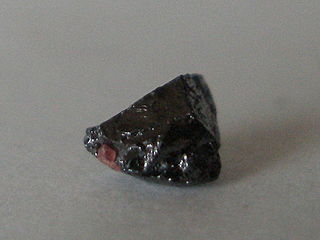
Armalcolite is a titanium-rich mineral with the chemical formula (Mg,Fe2+)Ti2O5. It was first found at Tranquility Base on the Moon in 1969 during the Apollo 11 mission, and is named for Armstrong, Aldrin and Collins, the three Apollo 11 astronauts. Together with tranquillityite and pyroxferroite, it is one of three new minerals that were discovered on the Moon. Armalcolite was later identified at various locations on Earth and has been synthesized in the laboratory. (Tranquillityite and pyroxferroite were also later found at various locations on Earth). The synthesis requires low pressures, high temperatures and rapid quenching from about 1,000 °C to the ambient temperature. Armalcolite breaks down to a mixture of magnesium-rich ilmenite and rutile at temperatures below 1,000 °C, but the conversion slows down with cooling. Because of this quenching requirement, armalcolite is relatively rare and is usually found in association with ilmenite and rutile, among other minerals.
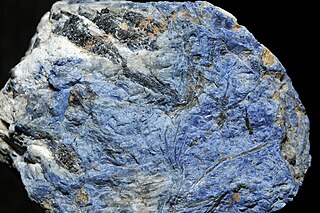
Dumortierite is a fibrous variably colored aluminium boro-silicate mineral, Al7BO3(SiO4)3O3. Dumortierite crystallizes in the orthorhombic system typically forming fibrous aggregates of slender prismatic crystals. The crystals are vitreous and vary in color from brown, blue, and green to more rare violet and pink. Substitution of iron and other tri-valent elements for aluminium result in the color variations. It has a Mohs hardness of 7 and a specific gravity of 3.3 to 3.4. Crystals show pleochroism from red to blue to violet. Dumortierite quartz is blue colored quartz containing abundant dumortierite inclusions.
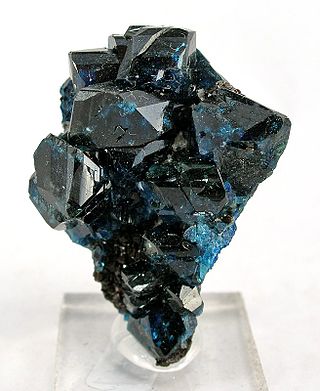
Lazulite ((Mg,Fe2+)Al2(PO4)2(OH)2) is a blue, phosphate mineral containing magnesium, iron, and aluminium phosphate. Lazulite forms one endmember of a solid solution series with the darker iron rich scorzalite.
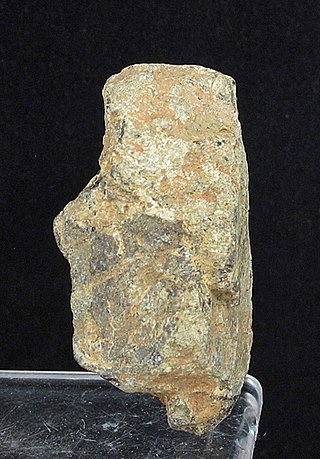
Polycrase or polycrase-(Y) is a black or brown metallic complex uranium yttrium oxide mineral with the chemical formula (Y,Ca,Ce,U,Th)(Ti,Nb,Ta)2O6. It is amorphous. It has a Mohs hardness of 5 to 6 and a specific gravity of 5. It is radioactive due to its uranium content. It occurs in granitic pegmatites.
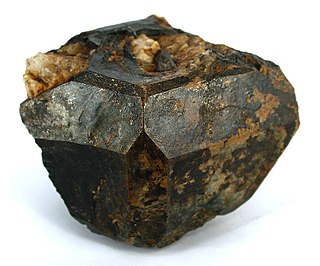
Microlite was once known as a pale-yellow, reddish-brown, or black isometric mineral composed of sodium calcium tantalum oxide with a small amount of fluorine. Its chemical formula is(Na,Ca)2Ta2O6(O,OH,F). Today it is a name of a group of oxide minerals of a similar stoichiometry having tantalum prevailing over titanium and niobium. The microlite group belongs to a large pyrochlore supergroup that occurs in pegmatites and constitutes an ore of tantalum. It has a Mohs hardness of 5.5 and a variable specific gravity of 4.2 to 6.4. It occurs as disseminated microscopic subtranslucent to opaque octahedral crystals with a refractive index of 2.0 to 2.2. Microlite is also called djalmaite, but both names are now obsolete.

Lorenzenite is a rare sodium titanium silicate mineral with the formula Na2Ti2Si2O9 It is an orthorhombic mineral, variously found as colorless, grey, pinkish, or brown crystals.

Titanowodginite is a mineral with the chemical formula MnTiTa2O8. Titanowodginite has a Mohs hardness of 5.5 and a vitreous luster. It is an iridescent dark brown to black crystal that commonly forms in a matrix of smoky quartz or white beryl in a complex zoned pegmatite.

Cafetite is a rare titanium oxide mineral with formula (Ca,Mg)(Fe,Al)
2Ti
4O
12·4(H
2O). It is named for its composition, Ca-Fe-Ti.

Neptunite is a silicate mineral with the formula KNa2Li(Fe2+, Mn2+)2Ti2Si8O24. With increasing manganese it forms a series with mangan-neptunite. Watatsumiite is the variety with vanadium replacing the titanium in the formula.

Siderophyllite is a rare member of the mica group of silicate minerals with formula KFe2+2Al(Al2Si2)O10(F,OH)2.

Betafite is a mineral group in the pyrochlore supergroup, with the chemical formula (Ca,U)2(Ti,Nb,Ta)2O6(OH). Betafite typically occurs as a primary mineral in granite pegmatites, rarely in carbonatites. Originally defined by the B-site atom Ti, the development of new nomenclature for mineral names led to modernization of the system for nomenclature of pyrochlore and betafite in order to further rationalize the naming process of this grouping of minerals. Only two of the mineral species that were formerly recognized as betafite are presently retained. They are oxyuranobetafite and oxycalciobetafite. The term betafite is now a synonym or varietal group name under the pyrochlore super group.
Alsakharovite-Zn (IMA symbol: Ask-Zn) is an extremely rare alkaline strontium zinc titanium silicate mineral from the cyclosilicates class, with the chemical formula NaSrKZn(Ti,Nb)4(Si4O12)2(O,OH)4·7H2O, from alkaline pegmatites. It belongs to the labuntsovite group.
Altisite (IMA symbol: Ati) is an exceedingly rare alkaline titanium aluminosilicate chloride mineral with formula Na3K6Ti2Al2Si8O26Cl3, from alkaline pegmatites. It is named after its composition (ALuminium, TItanium, and SIlicon).

Perhamite is a phosphate mineral with the formula Ca3Al7(SiO4)3(PO4)4(OH)3·16.5(H2O). It occurs in rare isolated masses in amblygonite-rich pegmatite deposits throughout the world. It was discovered in platy sheed form of 1mm hexagonal crystals. It was first described in 1977 by P.J. Dunn and D.E. Appleman from pegmatite collected from Bell Pit, Newry, Maine. Other specimens have been found in Kapunda, South Australia, in Silver Coin mine near Humboldt County, Nevada and various locations throughout Europe.

Ixiolite is an accessory oxide mineral found in granitic pegmatites. It is an oxide with the general chemical formula (Ta,Nb,Sn,Mn,Fe)4O8 or (Ta,Mn,Nb)O2.

Schiavinatoite is a very rare mineral, a natural niobium borate with the chemical formula (Nb,Ta)BO4. Schiavinatoite is classified as monoborate. It contains tetrahedral borate anion instead of planar BO3 group, which is more common among minerals. Schiavinatoite is one of the most simple niobium minerals. It forms a solid solution with its tantalum-analogue, béhierite. Both minerals possess zircon-type structure (tetragonal, space group I41/amd) and occur in pegmatites. Schiavinatoite and nioboholtite are minerals with essential niobium and boron.
Szklaryite is an extremely rare mineral with the formula []Al6BAs33+O15. It is essentially vacant ("[]"), arsenic-dominant member of dumortierite supergroup, giving a name of szklaryite group. It is one of three quite recently found minerals of this group, the other two being nioboholtite and titanoholtite, all coming from the Szklary village near Ząbkowice Śląskie in Poland. They occur in a unique pegmatite of probable anatectic origin.
Nioboholtite is an extremely rare mineral with the formula (Nb0.6[]0.4)Al6BSi3O18. It is the niobium-rich member of the dumortierite supergroup, and the niobium analogue of holtite of the holtite group. It is one of three quite recently found minerals of this group, the other two being titanoholtite and szklaryite, all coming from the Szklary village near Ząbkowice Śląskie in Poland. They occur in a unique pegmatite. Nioboholtite and schiavinatoite are both minerals with essential niobium and boron.

Seidozerite is a sorosilicate from the seidozerite supergroup (a "titanium disilicate"). It was first described by Semenov, Kazakova and Simonov in 1958. Its chemical formula is Na4MnZr2Ti(Si2O7)2O2F2 and its type locality is 'Pegmatite No. 58', Lake Seydozero, Lovozero massif, Kola peninsula, Murmansk Oblast.
References
- ↑ Warr, L.N. (2021). "IMA–CNMNC approved mineral symbols". Mineralogical Magazine. 85 (3): 291–320. Bibcode:2021MinM...85..291W. doi: 10.1180/mgm.2021.43 . S2CID 235729616.
- 1 2 3 4 Pieczka, A.; Evans, R. J.; Grew, E. S.; Groat, L. A.; Ma, C.; Rossman, G. R. (2013). "The dumortierite supergroup. II. Three new minerals from the Szklary pegmatite, SW Poland: Nioboholtite, (Nb0.6〈0.4)Al6BSi3O18, titanoholtite, (Ti0.75〈0.25)Al6BSi3O18, and szklaryite, 〈Al6BAs3+3O15". Mineralogical Magazine. 77 (6): 2841. Bibcode:2013MinM...77.2841P. doi:10.1180/minmag.2013.077.6.10. S2CID 51740732.
- 1 2 "Titanoholtite: Titanoholtite mineral information and data". Mindat.org. Retrieved 2016-03-03.